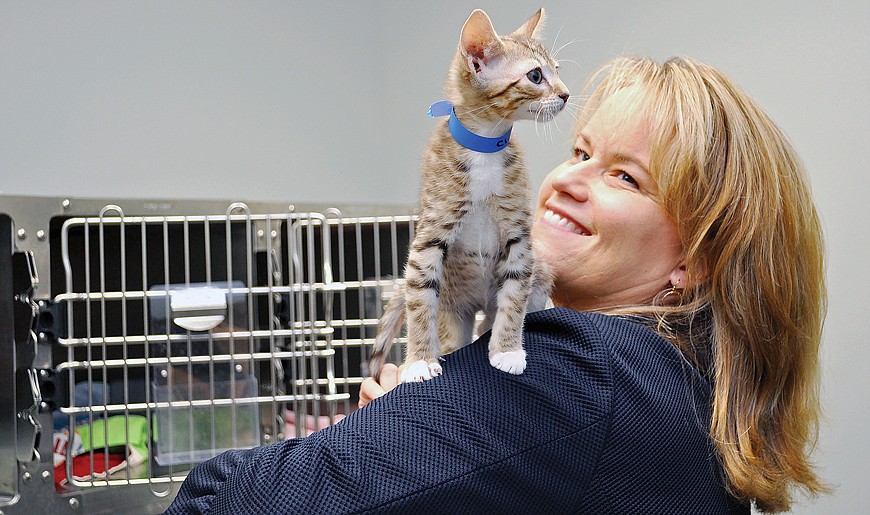- April 18, 2024
-
-
Loading

Loading

If they had a do-over, Sarasota businessmen Edward Sarbey and Ira Barsky probably would have given the charity they founded in 1999 a different name. When you hear Animal Rescue Coalition, what comes to mind? A shelter, right?
Animal Rescue Coalition, or ARC, is not a shelter. The nonprofit, located off Fruitville Road in East Sarasota County, specializes in providing low- and no-cost spay and neuter surgeries to dogs and cats in Sarasota, Manatee and surrounding counties.
“In the beginning, they did some rescue work,” says Mary Dietterle, ARC’s executive director and a resident of Country Club West. “But they realized that spay and neuter was going to have the most impact.”
If you really want to bail out an animal shelter, you turn off the flow of animals. When the intake numbers come down, that means that the animals in the shelters waiting for homes have more time to find homes.
Mary Dietterle
executive director, ARC (Above)
Most responsible pet owners have their dogs or cats undergo sterilization procedures. But they probably don’t think about it much after Fifi or Fido emerges from the post-surgical haze. In reality, spay and neuter procedures are crucial to keeping shelter populations down and preventing animals from being euthanized. Or as Dietterle puts it so directly, “The problem of animal homelessness cannot be solved by rescue alone. Spay and neuter is the only way to solve it.”
Unchecked, dogs and cats reproduce exponentially. In fact, some researchers have posited that a single unsterilized female dog could, over the course of seven years, be responsible for 96,000 puppies when accounting for multiple generations of offspring. Spay and neuter are the most effective deterrents; the increase in these procedures has been credited as the driving force behind an 80% drop in euthanasia of healthy animals over the past 20 years. Since 2010, Manatee and Sarasota counties have seen a 30% reduction in the intakes of dogs and cats at shelters, Dietterle says.
“Imagine you come home from work, walk into the house and there’s 2 inches of water on the floor, the drain is clogged and water is pouring over the side of the sink,” she says, delivering one of her go-to metaphors. “What’s the first thing you do?
“You turn off the faucet. If you really want to bail out an animal shelter, you turn off the flow of animals. When the intake numbers come down, that means that the animals in the shelters waiting for homes have more time to find homes.”
In nearly two decades, ARC has performed more than 53,000 surgeries. A full-time veterinarian, Dr. Lisa Tipton, does up to 35 a day in a large surgical suite designed to handle a high volume. Prices range from $60 for a male cat to $120 for a large female dog. At private vet offices, the procedures cost far more.
ARC charges less for low-income pet owners and even less for rescue organizations. Nate’s Honor Animal Rescue frequently uses ARC’s services, transporting about 75 cats and dogs a month to the facility for spaying and neutering. “Their low-cost service allows us to put more money toward other medical concerns,” says Honor’s Executive Director Dari Oglseby. “Plus, since the time I started here about 10 years ago, I’ve seen a drastic drop in the number of animals coming into our shelter, and spay and neuter is a major reason.”
Honor is a “no kill” facility, which means it will not accept a new animal if it’s at capacity. A handful of dogs have called the shelter home for more than two years. All animals accepted at Honor are spayed or neutered, and Oglesby estimates that around 95% of the dogs and cats they take in have not been sterilized.
Where do they come from? “In Lakewood Ranch, for instance, most pets are spayed or neutered, but if you head east into rural areas like Arcadia and Desoto County, or down into Charlotte County, there are not enough resources and awareness,” Dietterle says. “There’s a lot of dogs and cats running around that are not spayed or neutered.”
It’s why the organization has a van — to make runs to the hinterlands to pick up and deliver backwoods strays. And it’s also why ARC is conveniently located a short jog off Interstate 75.
ARC operates on a budget of roughly $750,000 a year, Dietterle says. Because it performs about 80% of its surgeries at a loss, it relies heavily on donations and grants. “As we grow our message and more and more people pay our full prices, we can reduce the loss margin,” Dietterle says. “That helps us make the surgeries available to anyone who needs it.”
A donation that covers the cost of “fixing” just one dog could theoretically prevent the births of thousands of unwanted puppies. If one fertile female dog, unfettered, can generate thousands of puppies, a $100 donation to pay for her spaying seems like a small price to pay — and a solid return on an investment.